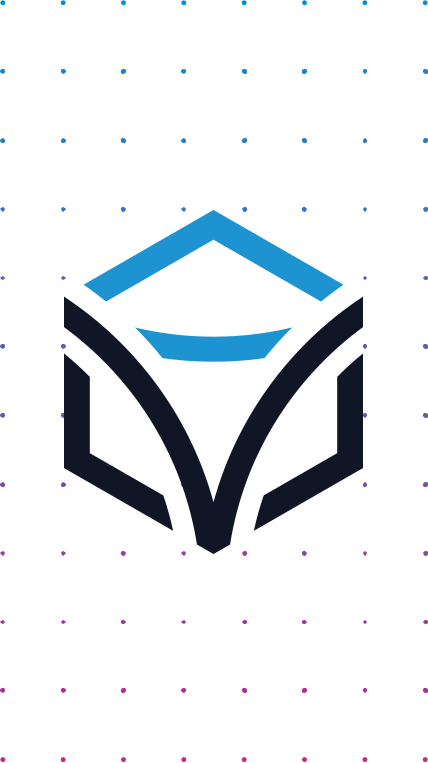Network Innovation Battleground
The network continues to evolve toward the cloud with the creation of a modern ecosystem consisting of public cloud providers and network specialists. The evolution of the public cloud has matured from the first years which consisted of a land grab whereby CIOs were pitched AWS as a destination for all of their workloads; to the current cloud landscape which looks more like a set of commodity products (IaaS, DB, ADC) with a growing set of differentiated services and offerings (AI/ML, GKE, Big Data), as well as SaaS vendors providing specific applications and network services (Zscaler, ServiceNow, Salesforce, Cato). The connectivity associated with these cloud services coupled with enterprise applications is creating a priority market for how to provide a connected ecosystem to efficiently and securely offer these transformational services.
The networking community has had an interesting response to this market evolution. Vendors that cater to the network team (Cisco, Juniper, SilverPeak) have put the branch as the center of this transformation ‘Branch-Out’ with SD-WAN offers. Vendors who cater to the cloud teams have obviously had a ‘Cloud-Out’ approach (Aviatrix, Alkira). Public cloud vendors who originally tried to build a walled garden understand the need to provide uniform, multi-cloud interfaces (AWS Transit Gateway, Azure Virtual WAN). One thing is clear – this is the battleground for network innovation and CIOs need to have a cohesive strategy.
CIOs have historically created two distinct groups within their organizations:
Network Team
This group focuses on traditional route/switch data center technologies coupled with branch and campus responsibilities. Local application responsibilities would include load balancers, firewall, and DDI (DNS, IPAM).
Cloud/Platform Team
This group focuses on AWS and Azure with a responsibility to applications which have been migrated to the cloud primarily as part of a digital transformation. They view the application developers as their customers and provide cloud infrastructure starting with a lift/shift mentality moving toward a cloud-native strategy.
In the past, these distinct groups have made a lot of sense as the skillsets and requirements for these two teams have historically been very different. The evolution of the cloud market to a highly distributed set of services has created a need to either merge these teams together or provide a common platform to facilitate the integration and automation needs for the digitally-transformed enterprise.
Break Down Barriers Between Cloud & Network Teams
The introduction of SD-WAN and multi-cloud are the first set of services which require the CIO to transform their operations. The reality is that digitally transformed businesses will rely on a large set of cloud and SaaS services which will require a robust connectivity, compliance, and security strategy. The traditional concepts of separating network and cloud concepts will no longer be a valid operational model.
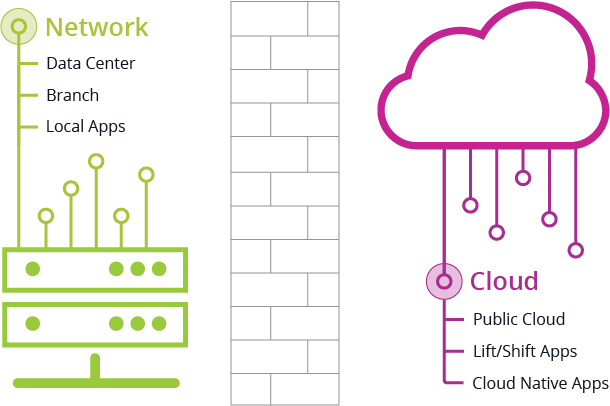
While Lines of Business don’t work for the CIO, they are taking a stronger role in application development and being the ultimate user of this infrastructure. The question is how to provide these users with self-service and Network-as-a-Service capabilities that allow them the flexibility to move at the speed and needs of digital transformation and their business. Governance and best practices will be the preferred model for engaging the application teams in the management of infrastructure and networking services.
Network of Clouds
The distribution of application and infrastructure services across a number of cloud locations is not a strategic goal but the byproduct of modern cloud innovation. The goal of infrastructure and IT teams is to provide the most robust service to support the business by providing secure and robust infrastructure.
The original cloud debate was whether hybrid cloud would be a temporary or permanent situation. AWS had a dominant position and many enterprise customers settled on a single source cloud strategy with the goal of moving as many workloads as possible to AWS. The original mentality of lift and shift to the cloud propelled many teams to recreate their data center strategies in the cloud. While AWS provides a robust ecosystem of infrastructure services, there is innovation happening at the platform and software layers of the cloud model being offered by a large and growing ecosystem of vendors.
It is now a reality that enterprises will consume infrastructure and applications from a number of vendors and cloud providers ‘as-a-service’.

Over 81% of Enterprise organizations are using more than one Public Cloud.
– Gartner
The market reaction to this reality has generated a mixed set of strategies:
Public Cloud Vendors
![]()
The race is on and AWS, Azure, and Google Cloud Platform (GCP) are innovating at a profound pace to differentiate themselves. This means workload migration will stall and applications will become sticky based on these unique offerings.
Private Cloud Vendors
![]()
RedHat, IBM, HP, and traditional data center vendors are promoting a move toward K8/container management with composable and integrated hardware with cloud-scale attributes..
Data Center Vendors
![]()
Existing vendors such as Cisco and VMWare are extending their technologies into the public cloud to attempt to provide a ubiquitous overlay environment.
Niche Center Vendors
![]()
Oracle and enterprise application vendors are providing hybrid offerings to both offer applications as a managed service but bundling with traditional cloud storage and network services.
Software Vendors
![]()
Salesforce, ServiceNow, Office365, GSuite, Slack, Box, NetSuite represent a small number of Enterprise IT software platforms that are the destination for much of the day-to-day work for enterprise customers.
Security Services
![]()
Zscaler, InfoBlox, PaloAlto represent a set of security services which are reshaping the firewall market to a service provided from the cloud.
Telco Cloud
![]()
Telecom vendors are offering edge capabilities paired with 5G services to innovate at the last mile providing infrastructure when it makes sense to host at the edge of the network.
The Network Management Plane Gap
An interesting observation is that although the delivery and programmability of network services is being disrupted, the underlying OSI model and basic networking concepts are unchanged. Data plane technologies continue to focus on optics, FPGA, and custom ASIC innovation. We continue to double-down on DWDM, Ethernet, IP, MPLS, with encapsulated and overlay IP networking.
The largest impact on networking teams is being provided at the control plane with centralized software control providing centralized programmability. While there is a large movement to make individual network elements programmable there are a number of negative factors:
NETCONF is relegated to IP network elements with low adoption in optical or data center networking.
REST interfaces typically support a minor set of features with less robust transactional support.
CLI continues to be the most robust (by feature support) with a large community of network engineers.
DevOps tools have focused on CLI support continuing to put additional technical debt into non-API interfaces.
The management plane has been largely overlooked with REST-ish interfaces dominating controller and orchestration platforms. We need robust investments in the management domain of networking if we hope to realize the benefits of modern cloud, SD-WAN, multi-cloud, and ultimately digital transformation initiatives.
How Automation Platforms Can Bridge the Gap
As businesses continue to expand toward leveraging cloud infrastructure, networking teams are propelled into needing to know how to provision and configure networking across not only disparate on-prem physical network infrastructure but also cloud network environments such as VPCs and VNets. There is a specialized skillset and a steep learning curve for connecting multiple types of devices to multiple cloud environments that is not satisfied by manual provisioning. This complex challenge causes network management, application performance, and compliance issues.
The evolution of the cloud market to a highly distributed set of services has created a need to either merge the networking and cloud teams together or provide a common platform to facilitate the integration and automation needs for the digitally transformed enterprise. Multi-cloud management highlights the need to adopt cloud constructs and drives network automation by providing a programmable network. By leveraging the right automation platform that can provide end-to-end automation through an API-first approach, connecting various domains to IT systems and platforms, both cloud and network teams can collaborate together to automate the Network of Clouds.
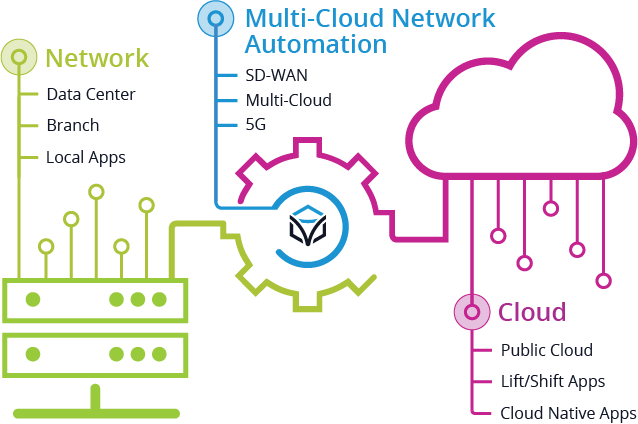
Automation & Integration Across Multiple Domains & Clouds with Itential
Itential’s products were built with the expectation that the networking market would migrate to an API-first mentality. While this migration has been slower than expected in the traditional networking domain, the modern application ecosystem has an expectation of utilizing a cloud-first strategy to leverage the latest features and capabilities.
Itential provides a common platform to facilitate the integration and automation needs for the digitally transformed enterprise:
Integrate with Your Entire Ecosystem
Robust ecosystem of adapter technologies, that integrate with any IT, networking or cloud technology, supported by three comprehensive strategies:
- Run-time adapter will take Swagger/OpenAPIv3 document and dynamically generate routes. This allows customers to leverage adapters as configuration (Swagger).
- Generate adapters via an online application based on Swagger or POSTMAN collections. This allows customers to generate a pre-built adapter and deploy as code.
- Adapter library is an Itential Automation Platform (IAP) module which allows customers to custom build integrations to alternate interfaces such as NETCONF, SOAP, and legacy interfaces. This library is utilized by Itential to build specific modules and available to customers.
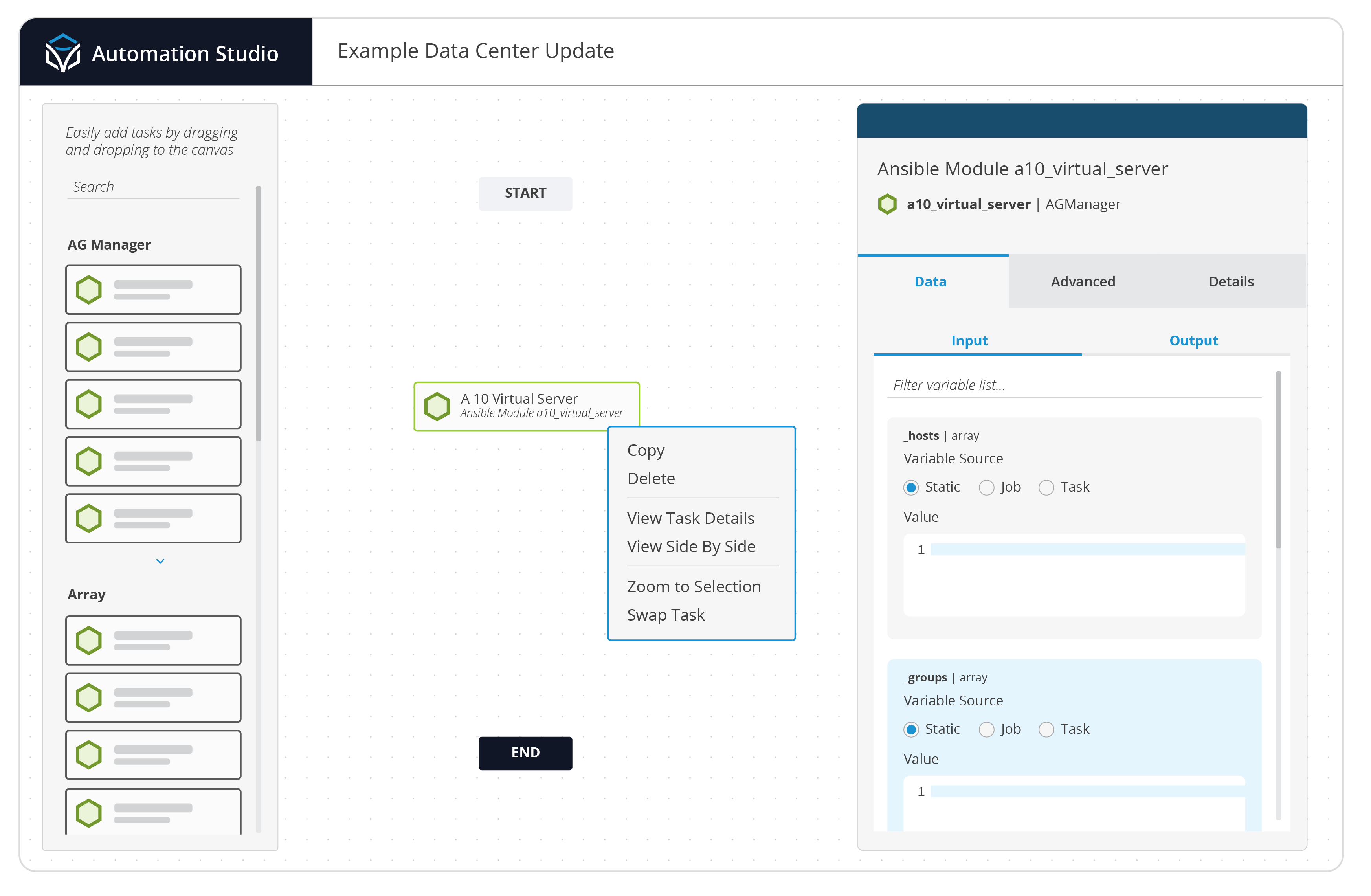
Create Workflow Logic in Automation Engine
Network automation requires loosely coupling of a variety of tasks in a predetermined process based on the activities required to manage a network. Core capabilities include:
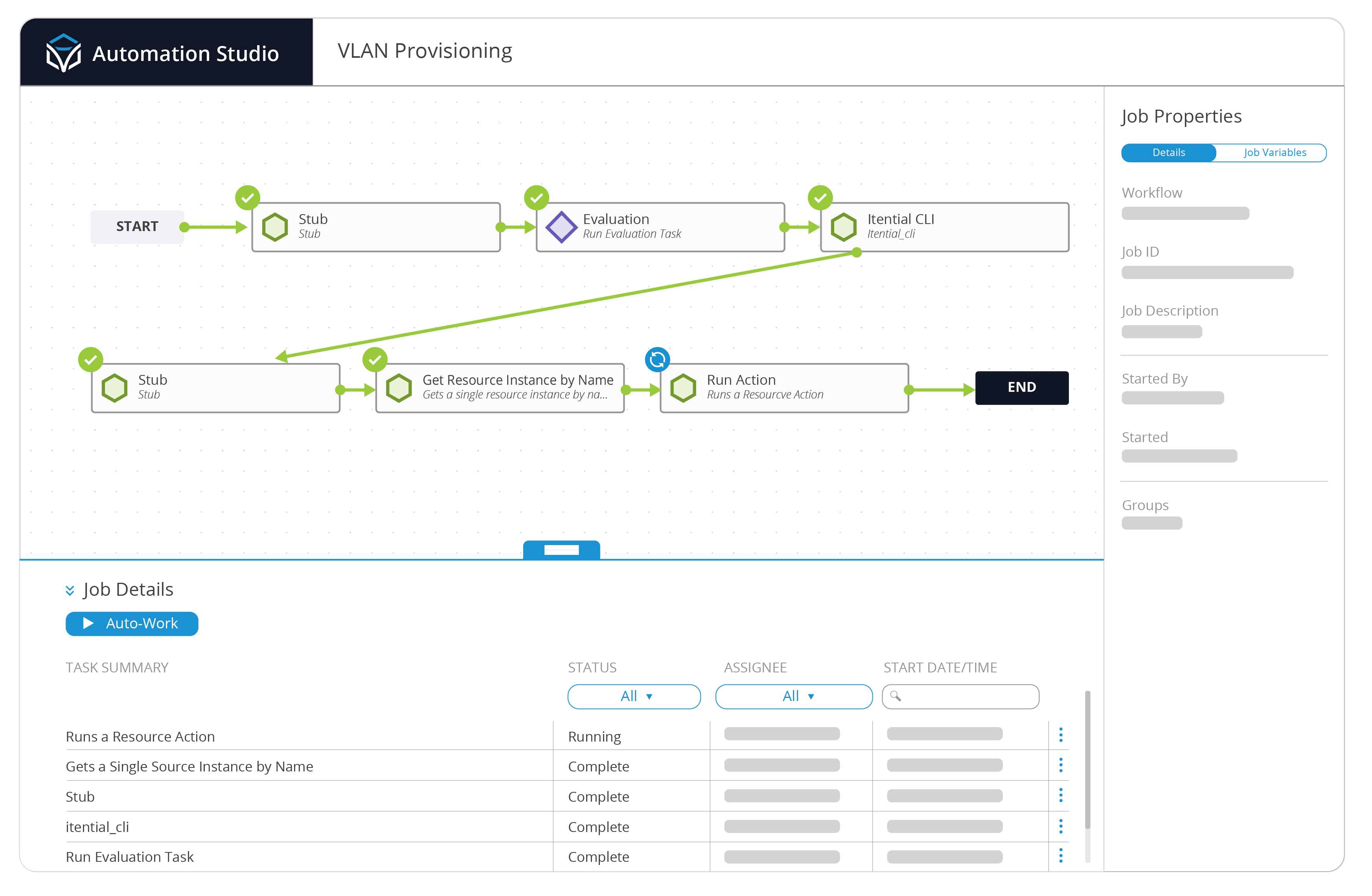
- Workflow logic is focused on machine-first mindset with all state machine logic to support robust and efficient process logic.
- Dynamic workflow model leverages run-time applications and adapters.
- Network intelligence based on the tasks available to the automations. Workflow Engine is decoupled from this intelligence which allows rapid innovation without disruption to the automation definition.
Collaborate in a Low-Code Environment
By providing a common platform in a no-low code environment, both cloud and network teams can easily collaborate to provide end-to-end automation.
- Pre-Built Automations provide out-of-the-box functionality to common use cases that enable rapid onboarding of automation principles.
- Automation reusability allows cloud and network teams to create and publish domain specific automations that can be used by other teams within their own workflows.
- Automations are defined using JSON Schema, which provides a structured and universal modeling language for that can be read, parsed, and utilized by teams like DevOps, for example.
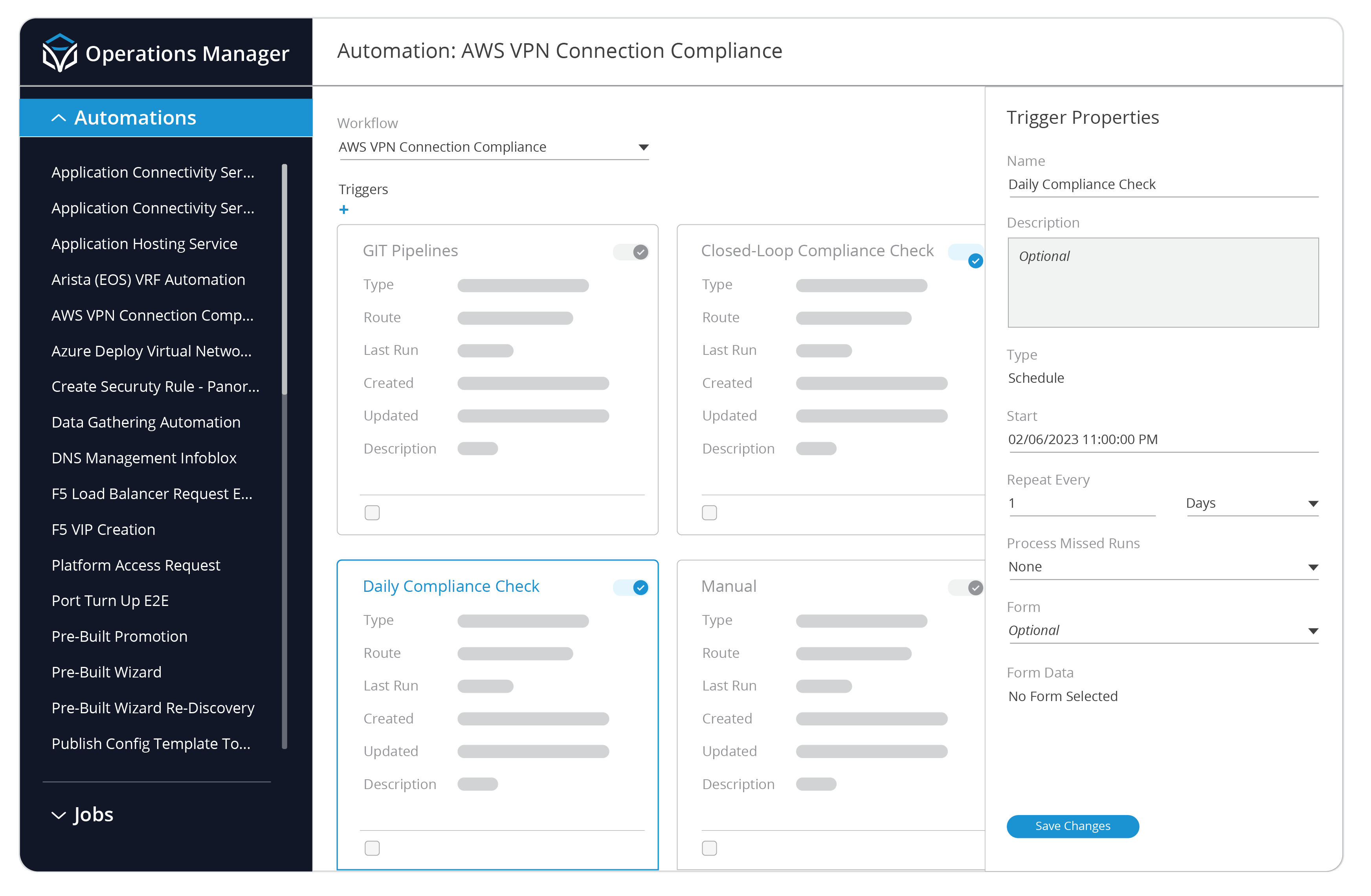
Why Itential for Multi-Cloud Network Automation
By leveraging the right automation platform that can provide end-to-end automation through an API-first approach, connecting various domains to IT systems and platforms, both cloud and network teams can collaborate together to automate the Network of Clouds.
Itential is purpose-built for today’s complex and distributed networks. Our low-code platform simplifies and automates complex multi-domain and multi-vendor networks and bridges the gap between IT, networking, and cloud teams by enabling users to easily build, execute, and visualize end-to-end network automations.
With Itential, organizations can:
- Increase Velocity & Quickly Realize Automation Value
- Maintain Flexibility & Scalability
- Automate Anything
